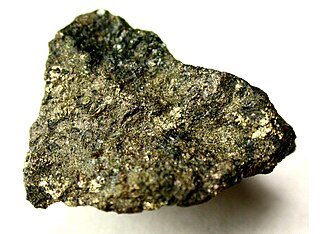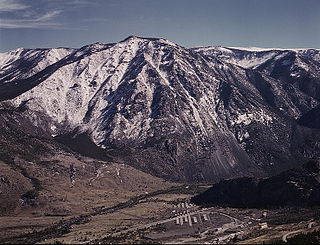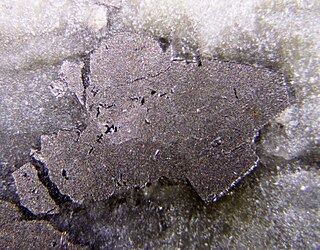Related Research Articles

Palladium is a chemical element; it has symbol Pd and atomic number 46. It is a rare and lustrous silvery-white metal discovered in 1802 by the English chemist William Hyde Wollaston. He named it after the asteroid Pallas, which was itself named after the epithet of the Greek goddess Athena, acquired by her when she slew Pallas. Palladium, platinum, rhodium, ruthenium, iridium and osmium form a group of elements referred to as the platinum group metals (PGMs). They have similar chemical properties, but palladium has the lowest melting point and is the least dense of them.
Stillwater or still water may refer to:

Pentlandite is an iron–nickel sulfide with the chemical formula (Fe,Ni)9S8. Pentlandite has a narrow variation range in nickel to iron ratios (Ni:Fe), but it is usually described as 1:1. In some cases, this ratio is skewed by the presence of pyrrhotite inclusions. It also contains minor cobalt, usually at low levels as a fraction of weight.
The platinum-group metals (PGMs), also known as the platinoids, platinides, platidises, platinum group, platinum metals, platinum family or platinum-group elements (PGEs), are six noble, precious metallic elements clustered together in the periodic table. These elements are all transition metals in the d-block.

Weloganite is a rare carbonate mineral with formula: Na2(Sr,Ca)3Zr(CO3)6·3H2O. It was discovered by Canadian government mineralogist Ann P. Sabina in 1967 and named for Canadian geologist Sir William Edmond Logan (1798–1875). It was first discovered in Francon Quarry, Montreal, Quebec, Canada and has only been reported from a few localities worldwide.

Pyrrhotite is an iron sulfide mineral with the formula Fe(1-x)S. It is a nonstoichiometric variant of FeS, the mineral known as troilite. Pyrrhotite is also called magnetic pyrite, because the color is similar to pyrite and it is weakly magnetic. The magnetism decreases as the iron content decreases, and troilite is non-magnetic. Pyrrhotite is generally tabular and brassy/bronze in color with a metallic luster. The mineral occurs with mafic igneous rocks like norites, and may form from pyrite during metamorphic processes. Pyrrhotite is associated and mined with other sulfide minerals like pentlandite, pyrite, chalcopyrite, and magnetite, and has been found globally.

Sperrylite is a platinum arsenide mineral with the chemical formula PtAs2 and is an opaque metallic tin white mineral which crystallizes in the isometric system with the pyrite group structure. It forms cubic, octahedral or pyritohedral crystals in addition to massive and reniform habits. It has a Mohs hardness of 6 - 7 and a very high specific gravity of 10.6.

A layered intrusion is a large sill-like body of igneous rock which exhibits vertical layering or differences in composition and texture. These intrusions can be many kilometres in area covering from around 100 km2 (39 sq mi) to over 50,000 km2 (19,000 sq mi) and several hundred metres to over one kilometre (3,300 ft) in thickness. While most layered intrusions are Archean to Proterozoic in age, they may be any age such as the Cenozoic Skaergaard intrusion of east Greenland or the Rum layered intrusion in Scotland. Although most are ultramafic to mafic in composition, the Ilimaussaq intrusive complex of Greenland is an alkalic intrusion.

Stillwater Mining Company is a palladium and platinum mining company with headquarters located at Littleton, Colorado, United States. It is the only palladium and platinum producer in the USA. The only other North America based palladium/platinum producer is North American Palladium, located in Canada. As of 2015, the President and Chief Executive Officer was Mick McMullen.

The Stillwater igneous complex is a large layered mafic intrusion (LMI) located in southern Montana in Stillwater, Sweet Grass and Park Counties. The complex is exposed across 30 miles (48 km) of the north flank of the Beartooth Mountain Range. The complex has extensive reserves of chromium ore and has a history of being mined for chromium. More recent mining activity has produced palladium and other platinum group elements.

Temagamite is a bright white palladium mercury telluride mineral with a hardness of 2+1⁄2 on the Mohs scale. Its chemical formula is Pd3HgTe3. It was discovered at the Temagami Mine on Temagami Island, Lake Temagami in 1973, and it represents a rare mineral in the Temagami Greenstone Belt.
Atheneite is a rare palladium, mercury arsenide mineral with the chemical formula (Pd,Hg)3 associated with palladium–gold deposits. Its composition parallels that of arsenopalladinite, isomertieite and meritieite-II.
The Lac des Îles igneous complex of northwestern Ontario, Canada is a layered gabbroic intrusion which is the host for the largest palladium orebody in Canada. The orebody is currently being mined as a combined open pit and underground operation by North American Palladium.

Braggite is a sulfide mineral of platinum, palladium and nickel with chemical formula: S. It is a dense, steel grey, opaque mineral which crystallizes in the tetragonal crystal system. It is the central member in the platinum group end-members cooperite and vysotskite.
Louis Jean-Pierre Cabri (born February 23, 1934 in Cairo) is an eminent Canadian scientist in the field of platinum group elements (PGE) mineralogy with expertise in precious metal mineralogy and base metals at the Canada Centre for Mineral and Energy Technology (CANMET). First as Research Scientist and later as Principal Scientist (1996–1999). In the 1970s he discovered two new Cu–Fe sulfide minerals, "mooihoekite" and "haycockite". In 1983 Russian mineralogists named a new mineral after him: cabriite (Pd2SnCu).
Kochite is a rare silicate mineral with chemical formula of (Na,Ca)3Ca2(Mn,Ca)ZrTi[(F,O)4(Si2O7)2] or double that. Kochite is a member of the rosenbuschite group.
Mooihoekite is a copper iron sulfide mineral with chemical formula of Cu9Fe9S16. The mineral was discovered in 1972 and received its name from its discovery area, the Mooihoek mine in Transvaal, South Africa.

Quintinite is a carbonate mineral with the chemical formula Mg4Al2(OH)12CO3⋅3H2O.
North American Palladium Ltd. is a former Canadian mining company that operated between 1968 and 2019 and that since 1993 operated the Lac des Iles mine in the Lac des Îles igneous complex of the Thunder Bay District of Ontario. The company primarily mined and explored for palladium but also for gold. Platinum, silver, nickel, and copper are mined as by-products. The company was listed on the Toronto Stock Exchange but was acquired by Impala Platinum in 2019.

Magnesiohastingsite is a calcium-containing amphibole and a member of the hornblende group. It is an inosilicate (chain silicate) with the formula NaCa2(Mg4Fe3+)(Si6Al2)O22(OH)2 and molar mass 864.69 g. In synthetic magnesiohastingsite it appears that iron occurs both as ferrous iron Fe2+ and as ferric iron Fe3+, but the ideal formula features only ferric iron. It was named in 1928 by Marland P. Billings. The name is for its relationship to hastingsite and its magnesium content. Hastingsite was named for the locality in Dungannon Township, Hastings County, Ontario, Canada.
References
- ↑ Warr, L.N. (2021). "IMA–CNMNC approved mineral symbols". Mineralogical Magazine. 85 (3): 291–320. Bibcode:2021MinM...85..291W. doi: 10.1180/mgm.2021.43 . S2CID 235729616.
- ↑ Cabri, L.J., and LaFlamme, J.H.G. (1974) Rhodium, Platinum, and Gold Alloys from the Stillwater Complex. Canadian Mineralogist, 12, 399-403.
- ↑ CaBri, L.J., LaFlamme, J.H.G., Stewart, J.M., Rowland, J.F., and Chen, T.T. (1975) New data on some palladium arsenides and antimonides. Canadian Mineralogist, 13, 321-335.
- ↑ Fleischer, M., Pabst, A., Mandarino, J.A., and Chao, G.Y. (1977) New Mineral Names. American Mineralogist, 62, 1060.
- ↑ Hänninen, E., Törnroos, R., and Lahti, S.I. (1986) Stillwaterite and associated platinum group minerals from the Siikakämä layered mafic intrusion, northern Finland. Lithos , 19, 87-93.
- ↑ Jones, W.R., Peoples, J.W., and Howland, A.L. (1960) Igneous and Tectonic Structures of the Stillwater Complex, Montana. Geological Survey Bulletin, 1071-H, 281-333.
- ↑ Klein, C., Dutrow, B. (2007) The 23rd Edition of the Manual of Mineral Science. 675 p. John Wiley & Sons, Hoboken, NJ.
- ↑ Watkinson, D.H., and Dunning, G. (1979) Geology and Platinum-Group Mineralization, Lac-des-Iles Complex, Northwestern Ontario. Canadian Mineralogist, 17, 453-462.
- ↑ Centers for Disease Control and Prevention (CDC) Accessed 19 November 2010.
- ↑ Mindat Accessed 8 September 2010.
- ↑ Webmineral Accessed 24 September 2010.